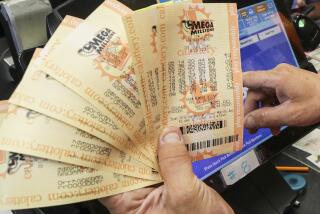Accused Lottery Cheaters : They Came for the T-Bird, Got Paddy Wagon Instead
- Share via
SACRAMENTO — The 16 contestants were excited as they were led into the darkened television studio at Cal Expo where the California Lottery’s “Big Spin” is taped each week. After all, Wednesday was to be their lucky day.
On the surface, at least, each had submitted $100 winning tickets and had been invited to participate in a new “second chance” lottery drawing for prizes ranging from new cars and ocean cruises to thousands of dollars in merchandise. Most brought their friends.
But instead of prizes, the 16 were led away in handcuffs and chains to an aging police paddy wagon, past rows of television cameras and gawking reporters to face charges that they had attempted to defraud the lottery.
The elaborate ruse was, in fact, a sting operation set up by lottery agents who said they wanted to deter people from submitting phony tickets.
“Instead of receiving T-Birds and cruises and merchandise, we were offering them free food and board, uniformed chauffeur-driven transportation. All the final decisions as to the ‘prizes’ will be determined by a judge,” said Lou Ritter, chief of lottery security.
At the same time, agents were attempting to cite or arrest in their homes in Southern California about 26 others on similar allegations of submitting crudely counterfeited “cut-and-paste” tickets in an attempt to claim $100 lottery prizes.
Of these, four were from Orange County, including Ricardo Covarrubaeas, 30, Anaheim; Merrilye Simkins, 34, Brea; Merle Jordan, 56, Anaheim, and an unidentified 17-year-old from Garden Grove, according to Hal Diaz, chief of Southern California security for the California Lottery.
Many of those arrested in Southern California “expressed great shock . . . great surprise,” he said. “One guy said, ‘Well, I played and got caught.”
Most are expected to face misdemeanor charges of presenting false claims and forging docments. On conviction, each charge carries a maximum penalty of six months imprisonment or a $500 fine.
More than 40 lottery agents took part in the sting which has been in the planning stages for more than three months.
Code-named “Operation Cap,” for cut and paste, most of the forged tickets were constructed from facsimiles of winning “Three of a Kind” game tickets printed on lottery brochures. The facsimiles were the same size and color as real tickets, and the suspects merely clipped them from the brochures and pasted them on top of losing tickets, officials said.
“They were pretty lousy,” Ritter said of the forgeries. “A novice would be able to quickly tell they were not, in fact, real tickets.”
Somewhat embarrassed lottery officials, however, conceded that they should never have printed brochures with exact-sized pictures of winning tickets. “It was a marketing decision, we didn’t think it would present this kind of a problem,” lottery official Bob Taylor confessed.
The idea of staging a sting was proposed after the forgeries had begun to make their way into lottery offices, and officials said they were frustrated by their inability to focus public attention on the problem.
Surprisingly, each person who submitted what appeared to be a phony ticket had been interviewed by an agent before being invited to Wednesday’s sham drawing. All those who were interviewed showed up, said Taylor. “We’ve really been scratching our heads about that,” he added.
‘Trying People in Media’
American Civil Liberties Union spokeswoman Daphne Macklin said the sting raises “a rather large issue of trying people in the media. These people came in and they had never gone before a judge or a jury. Clearly, if they went out in Southern California to arrest people at their homes, it was quite possible for them to do the same thing here.”
The sting was an elaborate scheme and officials went to great lengths to show it off.
The “contestants” began showing up at 8 a.m., and as they filed into Studio 1, they got a chance to glimpse the grand prize--a cream-colored Ford Thunderbird.
Inside, they were served coffee and doughnuts and listened to an explanation of the game rules. Agent Dick Stevens, a former Los Angeles police captain who acted as game show host, said he walked up and down the aisles trying to get people into the spirit of the occasion.
Pink and Blue Cells
Eventually, “winners” were called two by two into an adjoining studio. As each pair entered, agents greeted them, read them their legal rights and took them to jail cells on the grounds of Cal Expo--pink cells for the women, blue for the men.
The sting netted seven women and nine men. Ritter said they represented a cross-section of the public and included a schoolteacher and an active-duty serviceman.
“We have some good people here normally but they got caught up in the greed syndrome,” he said.
When told they were under arrest, Ritter said several broke down and cried while others said they had wondered how long it would take officials to catch them. One of those arrested had to be given special medical care because of a heart condition.
“I’m not really trying to embarrass anybody, really I’m not,” Ritter insisted before leading reporters on a tour of the scene and up a small hillside to view the suspects being taken to jail.
They were chained together and placed in a paddy wagon that officers said is normally used to pick up drunks in Sacramento’s Skid Row area.
More to Read
Sign up for Essential California
The most important California stories and recommendations in your inbox every morning.
You may occasionally receive promotional content from the Los Angeles Times.













